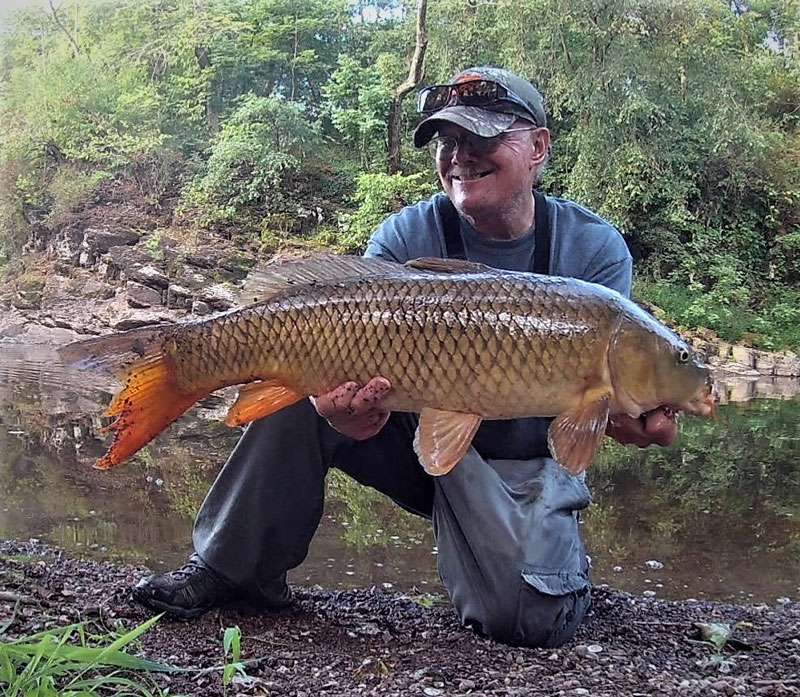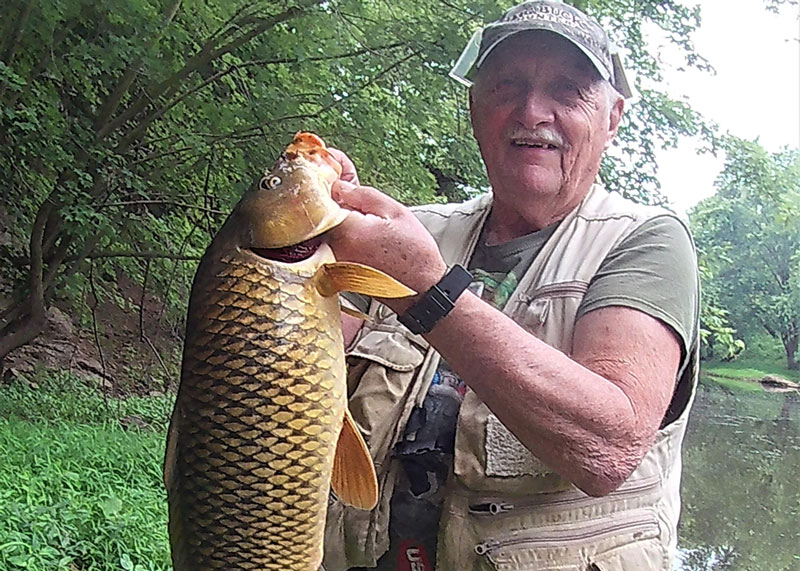There is a lot to be said for the lowly carp, an often demeaned and even hated gamefish species by some who seek “proper” gamefish. Yes, I’ll call the carp a gamefish and you carp-haters know who you are. Truly, it’s not the carps’ fault that they can survive almost any water type or condition. And it is certainly no drawback that they routinely exceed the 20-pound mark and even much more.

Carp are big, strong, spooky fish that often require a different gameplan from other species. In European countries carp are a premier gamefish in most venues, which often require a paid effort for heavily stocked and maintained fisheries designed especially for carp anglers. But back in real-world USA, carp have actually climbed up the ladder recently as more and more fishermen are starting to appreciate and take advantage of these “freshwater bonefish” that bolt with the slightest of movement or the casting of a shadow at the waters’ edge. Like the new invasive sensation, the northern snakehead, they seem to be everywhere. Almost every tributary to the Chesapeake and its surrounding reservoirs have them, yet bass and pan-fishing remain constant and in many cases have actually improved despite the presence of carp.
Late summer carping can run the gamut as far as techniques go. For my money, I’ll settle for deeper, cooler waters in our local river systems where concentrations of larger adults tend to gather and graze for a variety of bottom-dwelling critters like mollusks, crayfish, snails, clams, and any other invertebrate or insect larvae they can find. I know a few anglers that actively seek feeding carp on a fly rod in rivers like the Shenandoah and Upper Potomac. Others use European tactics with specialized gear, bite alarms, and hair-rigs for coaxing cautious giants. Still other anglers mix up a secret recipe of flavored dough baits that they both chum and fish with at their local haunts. All of these may work, but over the years I have come to enjoy the simple pleasures of dough balls, corn, and a forked stick along the riverbank.
Carp fishing doesn’t have to be complex to be successful. I fished with a group of anglers from southern Pennsylvania for several years who employed the European style of angling. They caught a ton of fish and many were large. Ever the conservationists, they would always release their catch. I learned a lot from them. Years later I would encounter a local, laid-back country guy who specialized in the classic bottom tactic of dough balls and corn for beefy fish. We became fast friends and soon Alvie Sickle and I were fishing for many species, in many waters, throughout Maryland and Pennsylvania.
Country Boy Carp Fishing Gear and Tactics
Alvie Sickle and I have been chucking his “secret” dough bait for several years now in a variety of lakes and rivers to enjoy the fight of many 30-inch plus fish, some as large as 38-inches, and it is likely we have lost bigger. The rig and concepts are simple: mold a firm doughball around a number-two baitholder style hook, and fish it on the bottom, weightless, on a 30-pound mainline of braid with a 15- to 20-pound mono leader to the snelled hook. We like medium-heavy spinning gear and keep our drags tight, but not too much so. Every reel has a drag system all its own. A drag that is set too tight will result in a carp that tears loose. Too light of a drag setting and the fish may well wrap you up in a sunken log or bury you in a heavy weed bed. Experiment with your spinning gear with 2000 to 3000 series reels and adjust accordingly.

In many tidal and freestone systems of the Chesapeake you can kayak to quieter, secluded areas where gatherings of big carp are more likely to be found and are less skittish. Sickle likes to pull his SOT yak on the shore and use the vessels’ rod holders to secure static baits in prime eddies or deeper pools. Carp are a lot like humans in that when it’s hot they want to be cool. Hence, early morning hours are likely the coolest part of the day even in Indian Summer conditions well into September and late October. Early morning air temperatures are also easier on the human anatomy than mid-day heat.
With a medium drag setting, Sickle sets his baits on a tight line with the bail closed. When a carp hits, the seven-foot rod buckles over and the fish has usually hooked itself on the initial bolting run. He then wrestles the rod out of the holder and may, or may not, tighten the drag depending on the size of the fish. Carp are not as structure-oriented as other gamefish and often graze the bottom in soft, featureless flats or pools that are shaded or deeper than surrounding areas. But some of our favorite locations do have fallen trees or large boulders that can spell danger when trying to control a 20-pound fish. Expect at the very least a long, powerful run at the onset of a fight with a big fish.
Carp Fishing Added Attractions
Pre-baiting, or chumming, is a tactic used by many carp anglers who utilize the European style. It is used primarily to draw fish to shore-bound anglers from open, stillwater venues and to get the fish to come to you and acclimate to a consistent supply of easy morsels. However, in moving or tidal environs, baiting is seldom needed to draw fish as they will almost always gather and feed in slower, deeper pools and eddies away from the main river currents. River flows change daily, and baiting areas often see the free offerings drifting downstream to areas you may not be able to fish.
We like to make it easy on ourselves and fish no later than 12 noon in the late summer heat. Sometimes we may use corn or smaller cut baits if channel catfish are available (as they are in many of these types of waterways) and keep a good supply of number-two and number-four baitholder style hooks along with 15- to 20-pound test clear mono for leader material. Carp fishing is available all summer long but as the days get shorter and night winds cool the big fish come out to play and the fishing is, well, laid-back! And besides, I see nothing wrong with fighting a half-dozen fish that run from 10 to 20 pounds each. Regardless of their gamefish status, carp are a worthy, available, and affordable big fish option almost everywhere you go.
Dough Balls for Carp Fishing
Here’s a quick recipe to make enough doughballs for an outing. Get a loaf of any soft bread, white or wheat, and tear the crusts off of six or eight slices. Put the bread in a bowl and break it up into small pieces. Mix a pack of strawberry gelatin mix in another bowl then pour the liquid into a spray bottle. Start spraying the bread with the liquid mix and kneed and mold it with your hands into a pliable but firm doughy paste. Be careful not to make the mix too wet.
Using plastic gloves during this process helps keep the mess down. As you form the dough you can add other flavoring such as sugar, cinnamon, salt, or canned kernel corn. When you have a nice consistency, you can either form bait-sized doughballs and put them in Ziplock bags or the whole loaf can go into a bag. Refrigerate the prepared dough baits and grab them when the next carp trip comes up. Don’t be afraid to experiment with flavorings and additives, as different people have their own favorite “secret” mixes. Good luck!
-By Jim Gronaw